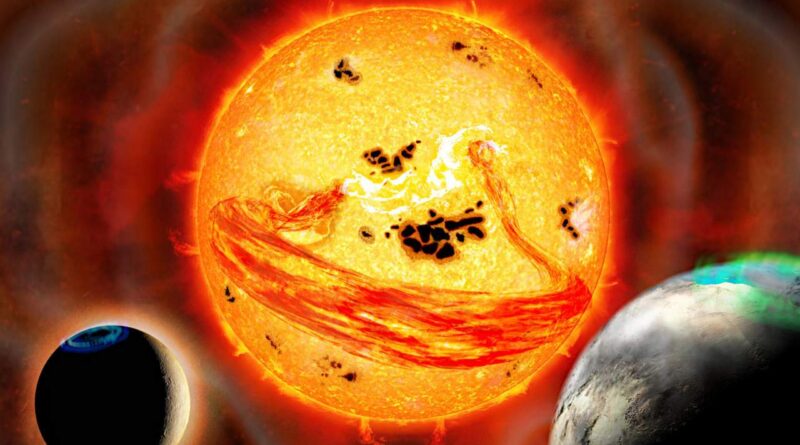This sun-like star just shot a warning flare at the future of humanity
Without the sun, life will we know it would be impossible. While the sun is over 91 million miles from Earth, its solar flares and coronal mass ejections (CME) can significantly impact our planet. Recently researchers from the University of Colorado Boulder were researching a star system over 111 light-years away from our planet and observed something interesting.
The star, EK Draconis, had a massive CME that was much more powerful than anything ever observed on the sun. A CME, sometimes known as a solar storm, occurring on the sun can significantly impact the Earth by disrupting satellites in orbit and the power grid on the ground. CMEs occur regularly on the sun and throw massive plasma clouds into space the travel millions of miles per hour. The CME that happened on EK Draconis was significantly larger than any CME the sun has ever produced in recorded history.
The star, EK Draconis, had a massive CME that was much more powerful than anything ever observed on the sun. A CME, sometimes known as a solar storm, occurring on the sun can significantly impact the Earth by disrupting satellites in orbit and the power grid on the ground. CMEs occur regularly on the sun and throw massive plasma clouds into space the travel millions of miles per hour. The CME that happened on EK Draconis was significantly larger than any CME the sun has ever produced in recorded history.
CMEs are often observed after a star produces a flare, which is a burst of radiation that extends far out into space. The image below shows a solar flare occurring on the sun’s surface provided by NASA. According to study researchers, young sun-like stars scattered throughout the galaxy experience frequent superflares, similar to the solar flares on the sun but much more powerful. Superflares can be tens to hundreds of times more powerful than the flares occurring on the sun.
While superflares occur more regularly on younger stars, they could still occur on the sun. Scientists believe massive flares could occur on the sun every several thousand years. That fact led the researchers to wonder if a massive CME could occur after a massive superflare. To answer that question, the scientists begin the study EK Draconis, which is about the same size as the sun but only 100 million years old. For comparison, the sun is estimated to be over 4.6 billion years old.
Notsu says that EK Draconis is what our sun looked like 4.5 billion years ago. For their study, the team observed the star for 32 nights during the winter and spring of 2020. Observations were conducted using the NASA Transiting Exoplanet Survey Satellite and the SEIMEI telescope at Kyoto University. During their observations, the star produced a very large superflare, and about 30 minutes after the flare, the team observed what appeared to be a CME erupting from the star’s surface.
The team was only able to observe the first step in the life of the CME, called the filament eruption phase. While they only observed the first phase of the CME, it was enough to determine that it was extremely large and moving at about 1 million miles per hour. The findings suggest that a similarly massive superflare and CME could occur on the sun.
However, the team admits phenomena like superflares and CMEs are likely rare for a star as old as the sun. Scientists believe the sun has another 7 to 8 billion years left in its life. Notsu believes CMEs and superflares such as the ones observed on EK Draconis could have been common earlier in the life of the sun. Such phenomena could have helped shape Earth and Mars into the planets we know today.
Notsu believes the thin atmosphere Mars has today could result from being impacted by a massive CME. Scientists know that Mars had a much thicker Earth-like atmosphere in the distant past. Evidence is also mounting that Mars had liquid water on its surface in the distant past. Notsu believes there’s a possibility that Mars could’ve been hit by material from a CME similar to what was observed on EK Draconis, turning it into the barren planet we see today.

